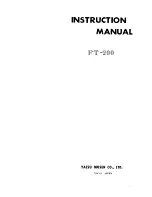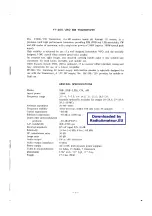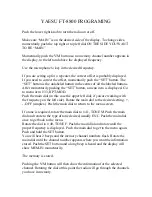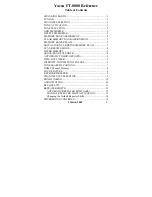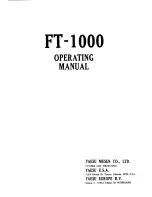
Appendix B
Air Conditioning Considerations
B.1
Air Conditioning
A common practice is to set the transmitter into a wall, cooling
it with outside air while providing air conditioning for the front
side to cool personnel and equipment. In severely polluted areas,
however, it may be desirable to run the transmitter on air-condi-
tioned air to avoid bringing in salt spray, soot, gaseous contami-
nants, etc.
Any electronic system is most reliable and component life long-
est when operated at moderate temperatures. The amount of air
conditioning required will depend on several factors. Sharing the
air conditioning load among a distributed system of smaller units,
rather than using one large central system, is strongly recom-
mended so that operation can continue in the event of the failure
of one unit.
B.2
Heat Load Estimate Guide
Table 2-1 contains a guide that may be useful in estimating the
required air conditioning capacity. Air conditioning units are
usually rated in “tons” of cooling capacity with one ton equal to
12,000 BTU per hour.
The “sensible heat load” is the sum of heat loads such as solar
radiation and heat generated by equipment and personnel in the
air-conditioned area. Again, we recommend consulting profes-
sionals experienced in the area of HVAC design to ensure satis-
factory results.
FACTOR
ITEM BTU-PER-HOUR LOAD
EXTERIOR OR WALL AREAS EXCLUDING WINDOWS.
5 to 11 BTU/hour/square foot, dependent on sun
exposure.
INSULATING GLASS (NO COVER).
22 to 77 BTU/hour/square foot, dependent on sun
exposure.
INSULATING GLASS (COVERED WITH SHADES OR TINTED.)
21 to 51 BTU/hour/square foot, dependent on sun
exposure.
ROOF AREAS WITH CEILING UNDERNEATH.
4 to 7 BTU/hour/square foot, dependent on roof insulation.
INTERIOR WALLS BETWEEN UNCONDITIONED AREAS.
8 to 14 BTU/hour/square foot, dependent on partition
material.
FLOOR AREAS EXPOSED TO UNCONDITIONED AREAS.
9 to 50 BTU/hour/square foot dependent on environment.
LIGHTING.
3.4 BTU/hour per watt.
PERSONNEL.
500 BTU/hour per person.
FRESH AIR VENTILATION
340 to 825 BTU/hour/person, dependent on condition of
incoming air.
PERIPHERAL EQUIPMENT.
3.4 BTU/hour per watt.
GROWTH AND SAFETY FACTOR.
30% of total BTU/hour.
TOTAL COOLING LOAD.*
130% of total BTU/hour.
MINIMUM SENSIBLE COOLING.*
85% of TOTAL COOLING LOAD.
* The TOTAL HEAT LOAD is calculated as the sum of the sensible-heat load and the latent-heat load.
Table B-1. Heat Loading Guidelines
888-2457-001
B-1
WARNING: Disconnect primary power prior to servicing.
Summary of Contents for Platinum HT EL 2000LS
Page 4: ...This page left blank intentionally...
Page 6: ......
Page 8: ...ii...
Page 12: ...This page left blank intentionally...
Page 38: ...This page left blank intentionally...
Page 46: ...This page left blank intentionally...
Page 54: ...This page left blank intentionally...



















